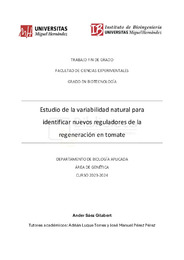Please use this identifier to cite or link to this item:
https://hdl.handle.net/11000/33182Full metadata record
| DC Field | Value | Language |
|---|---|---|
| dc.contributor.advisor | Luque Torres, Adrián | - |
| dc.contributor.advisor | Pérez Pérez, José Manuel | - |
| dc.contributor.author | Sáez Gilabert, Ander | - |
| dc.contributor.other | Departamentos de la UMH::Biología Aplicada | es_ES |
| dc.date.accessioned | 2024-09-17T11:16:18Z | - |
| dc.date.available | 2024-09-17T11:16:18Z | - |
| dc.date.created | 2024-06 | - |
| dc.identifier.uri | https://hdl.handle.net/11000/33182 | - |
| dc.description.abstract | En estudios anteriores, se han identificado en el laboratorio del Prof. José Manuel Pérez Pérez varios polimorfismos que presentaban una asociación significativa con la formación de callos ectópicos en las líneas de la colección Varitome-COMAV cuando se cultivan in vitro. En este trabajo se ha evaluado la eventual cosegregación entre uno de estos polimorfismos y la formación de callo ectópico en cuatro familias F2 obtenidas tras el cruzamiento de dos líneas de Solanum lycopersicum y otras dos de S. pimpinellifolium que formaban callos ectópicos con otras líneas que no los formaban. Para determinar la presencia de este polimorfismo, se ha llevado a cabo un análisis de CAPS tras la amplificación por PCR de la región del ADN genómico que contiene dicho polimorfismo. Además, se ha determinado el fenotipo de crecimiento temprano y la formación de raíces adventicias en respuesta a herida en plántulas mutantes more adventitous roots (mar), aisladas previamente por una mayor producción de raíces adventicias en el tallo en condiciones de invernadero. | es_ES |
| dc.description.abstract | In previous studies, in the laboratory of Prof. José Manuel Pérez-Pérez, several polymorphisms were identified that showed a significant association with the formation of ectopic callus in the lines of the Varitome-COMAV collection when cultured in vitro. In this work, the subsequent cosegregation between one of these polymorphisms and the formation of ectopic callus was evaluated in four F2 families obtained after crossing two Solanum lycopersicum and two S. pimpinellifolium lines that formed ectopic callus with other lines that did not. To determine the presence of this polymorphism, a CAPS analysis was performed after PCR amplification of the region of genomic DNA containing this polymorphism. Furthermore, the early growth phenotype and the formation of adventitious roots in response to wounding were determined in more adventitous roots (mar) mutant seedlings, previously isolated by a greater production of adventitious roots in the stem under greenhouse conditions. | es_ES |
| dc.format | application/pdf | es_ES |
| dc.format.extent | 39 | es_ES |
| dc.language.iso | spa | es_ES |
| dc.publisher | Universidad Miguel Hernández de Elche | es_ES |
| dc.rights | info:eu-repo/semantics/openAccess | es_ES |
| dc.rights.uri | http://creativecommons.org/licenses/by-nc-nd/4.0/ | * |
| dc.subject | Solanum lycopersicum | es_ES |
| dc.subject | Solanum pimpinellifolium | es_ES |
| dc.subject | formación de callo | es_ES |
| dc.subject | raíces adventicias | es_ES |
| dc.subject | Cleaved Amplified Polymorphic Sequences (CAPS) | es_ES |
| dc.subject | callus formation | es_ES |
| dc.subject | adventitious roots | es_ES |
| dc.subject.classification | Área de Genética | es_ES |
| dc.subject.other | CDU::5 - Ciencias puras y naturales::57 - Biología | es_ES |
| dc.title | Estudio de la variabilidad natural para identificar nuevos reguladores de la regeneración en tomate | es_ES |
| dc.type | info:eu-repo/semantics/bachelorThesis | es_ES |

View/Open:
Saez_Gilabert_Ander.pdf
1,97 MB
Adobe PDF
Share:
.png)
